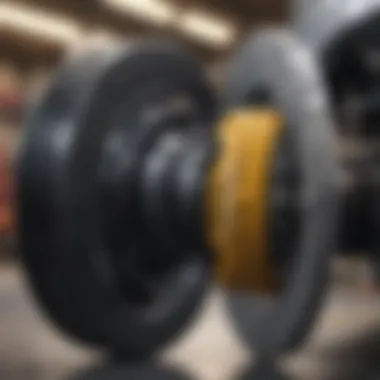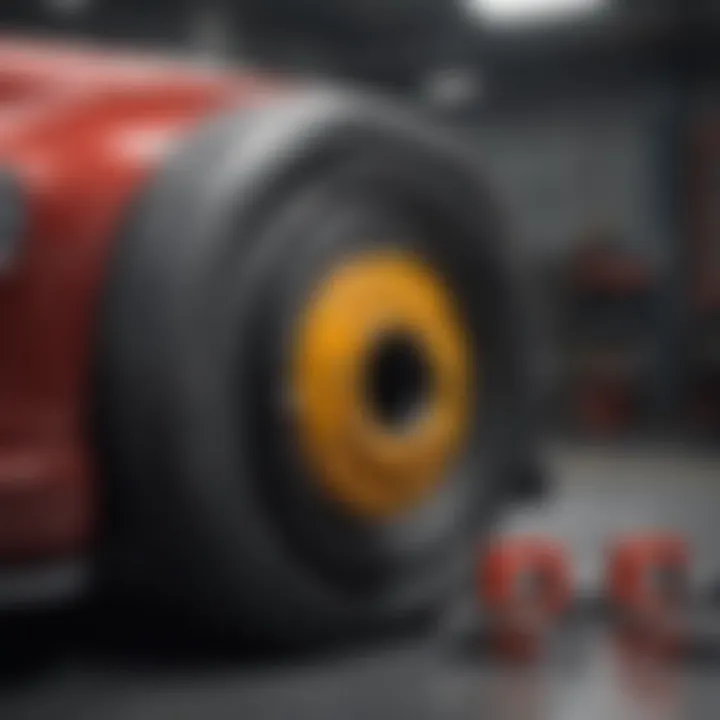Exploring Drum Brake Components and Their Functions


Intro
Drum brakes, found in many vehicles across the globe, are a classic component of automotive engineering. They function not just as mechanisms to slow down or stop a car, but as systems that ensure safety and performance. To truly appreciate drum brakes, it’s essential to dive deep into their components and how they work together. Understanding their design, function, and maintenance will equip automotive enthusiasts, as well as everyday vehicle owners, with knowledge that enhances their driving experience and promotes vehicle longevity.
In this exploration, we’ll unpack key elements associated with drum brakes. We’ll discuss the intricate parts that compose braking systems, clarifying their functions and the variations found in different vehicles. Alongside this, we’ll touch on maintenance tips that keep these components in optimal condition. Whether you are eyeing that classic car or cruising in a modern sedan, knowledge of drum brakes can inform your decisions and interactions with vehicle technology.
Preamble to Drum Brakes
Drum brakes represent a fundamental aspect of automotive safety and functionality. Understanding how these brakes operate, along with their various components, is vital for anyone interested in vehicle mechanics. With their unique design and effective performance characteristics, drum brakes are not just relics of the past; they continue to play a key role in many vehicles today. This section provides an overview of the essential elements that will be discussed in this article, illustrating both the significance and complexity of drum brake systems.
Overview of Braking Systems
Braking systems have evolved tremendously over time, with technologies adapting to meet the demands of modern driving. Broadly speaking, brakes can be split into two primary types: disc brakes and drum brakes. While disc brakes increasingly dominate the market, especially in high-performance vehicles, drum brakes remain a popular choice for many manufacturers. They tend to be cost-effective and maintain good performance in various driving conditions. Understanding the overall workings of braking systems adds depth to how we appreciate drum brakes, which function effectively under typical driving scenarios.
- Types of Braking Systems
- Disc Brakes: Known for their powerful stopping capabilities and heat dissipation properties.
- Drum Brakes: Generally reliable and simpler, often used in rear wheels and older models.
Knowing the structural differences between these braking systems highlights why drum brakes, with their specific parts and mechanisms, still deserve attention.
Prelude to Drum Brake Mechanics
When you peel back the layers of drum brake construction, each component reveals its role in contributing to the braking process. A typical drum brake assembly includes parts like the brake drum, shoes, wheel cylinder, and additional hardware that ensure the system functions fluidly. What sets drum brakes apart is the way they engage and disengage during a driving scenario. With an expansive area for friction and a self-energizing feature, drum brakes often provide sufficient stopping power despite their more traditional design.
One cannot overlook the benefits of drum brake systems:
- Cost-Effectiveness: Generally, they are more affordable than disc brakes.
- Less Complex Installation: Many mechanics find them easier to install and repair.
- Longer Service Life: Drum brakes can often outlast their disc counterparts under certain driving conditions.
Understanding this intricacy plays a pivotal role in knowledge for both automotive enthusiasts and everyday drivers alike, offering insights that could prove advantageous when considering maintenance and performance upgrades for vehicles.
Main Components of Drum Brakes
Understanding the main components of drum brakes is crucial to grasp how these systems function to bring vehicles to a halt safely. Each part has its unique role and contributes to the overall braking efficiency and safety of a vehicle. Whether it’s the brake drum or the wheel cylinder, recognizing these elements allows for better insight into potential issues that may arise and the appropriate maintenance needed.
Brake Drum
Material Composition
The brake drum is often made from cast iron or, in some cases, aluminum alloys. Cast iron is the most widely used due to its hardness and durability. This material can withstand the high temperatures generated during braking while maintaining its structural integrity. The key characteristic of cast iron is its ability to absorb heat, making it a popular choice in automotive applications. Compared to aluminum, it is more resistant to wear and can handle high-stress conditions without deforming.
The unique feature of using cast iron is its cost-effective nature, alongside its performance under extreme conditions. It’s beneficial in providing a long service life, but the downside could be its weight. Heavier elements could lead to overall increased vehicle mass, potentially affecting fuel efficiency.
Functionality and Design
The design of the brake drum plays a significant role in its functionality. With its cylindrical structure, it allows ample surface area for the brake shoes to make contact during braking. This design is engineered to facilitate a gradual heat dissipation process, which is crucial during prolonged stops or in situations requiring heavy braking.
A key characteristic of this functionality is how the cylindrical shape aids in even wear of the brake shoes. This allows them to provide maximum friction when needed. However, the downside is that drum brakes can be prone to fading due to overheating if not adequately maintained, a significant concern in performance-critical applications. Some aficionados argue that disc brakes have surpassed drum systems, particularly for high-performance vehicles, due to better heat management capabilities.
Brake Shoes
Types of Brake Shoes
Brake shoes come in various types primarily based on their construction and the materials used for their linings. These can include asbestos-free lined, ceramic, or metallic shoes, each serving specific purposes and conditions. For example, a common option is the asbestos-free lining which is crafted from materials that do not produce hazardous particles.
The key characteristic of these different types is their effectiveness in different driving conditions. For instance, ceramic shoes offer great performance and less dust but can be pricier. Conversely, traditional materials can still prove effective but may produce more debris. Understanding these types is essential, particularly when considering replacements and upgrades.
The unique feature of ceramic brake shoes, for example, is their ability to resist fade under high-performance conditions. This durability comes at a higher cost, yet many enthusiasts find it well worth the investment considering their performance benefits in extended use.
Wear Patterns and Replacement
As brake shoes wear down, they exhibit specific patterns which can indicate the health of the braking system. Common patterns include uneven wear on the lining or a shiny appearance, indicating overheating. Monitoring these can help in diagnosing potential issues early, which is integral for maintaining optimal brake performance.
A key characteristic here is the importance of timely replacements based on wear patterns. Many experts suggest checking these patterns at least once a year as part of regular maintenance. Replacing worn shoes prevents further damage to the drum itself and ensures safety.
The unique feature in wear management is the identification of different wear types. Knowing these can lead to informed decisions in maintenance or replacements, fostering a proactive approach to vehicle safety.
Wheel Cylinder
Mechanism of Action
The wheel cylinder is a hydraulic device that converts fluid pressure into mechanical force, pushing the brake shoes outward against the brake drum. This mechanism is essential in applying the needed pressure to stop the vehicle effectively. When the driver presses the brake pedal, brake fluid is directed to the wheel cylinder.
The key characteristic of this mechanism is its responsiveness. A well-functioning wheel cylinder translates driver input into immediate braking action. However, if there’s even a minor leak or malfunction, the efficiency can drop dramatically, leading to potentially unsafe driving conditions.


A unique feature of the wheel cylinder's design is its dual-piston arrangement found in many modern applications. This setup allows for more balanced braking force across the shoes, leading to more consistent stopping power. Neglecting the health of the wheel cylinder can result in uneven wear and reduced overall braking performance.
Role in Braking Performance
The role of the wheel cylinder directly ties back to the effectiveness of the entire braking system. Its performance not only guarantees the immediate application of brakes but also affects how smoothly a vehicle halts, impacting overall control.
A key characteristic of the wheel cylinder's role is linked to safety; if it fails, it can lead to one-sided braking, increasing the risk of skidding or loss of control. This is a serious concern, especially for drivers who navigate hilly terrains or inclement weather conditions. Keeping this component in check ensures reliability.
The unique feature of the wheel cylinder's construction is how it allows service technicians to assess its integrity easily. Regular inspections can reveal not only leaks but also corrosion or wear that could compromise the safety of the vehicle. A proactive stance on maintenance can thus prevent costly replacements and ensure safe driving.
Return Springs
Importance in Brake Operation
The return springs in drum brake systems play an understated yet vital role in ensuring that brake shoes retract correctly after the braking force is released. This retraction is essential for preventing the shoes from dragging against the drum, which can cause premature wear and overheating.
The key characteristic of these springs is their ability to restore the system to its original position once the brake pedal is released. This not only enhances the longevity of the brake components but also increases overall vehicle responsiveness.
Their unique feature is the tension maintained by these springs, which assists in ensuring that the brake shoes are properly positioned when not engaged. Neglecting the health of return springs can lead to significant issues such as increased pedal effort or diminished braking efficiency, so routine checks are necessary.
Spring Types and Attributes
Return springs are typically made from high-tensile strength materials, which allows them to endure repeated compression cycles. Various types of springs can be found, including coil springs or leaf-type springs, each with distinct attributes suited for specific brake designs.
The key characteristic of these springs lies in their specification based on the design of the braking system. A well-chosen return spring aligns with the unique pressure needs of the brake system, ensuring optimal operation under different driving conditions.
The unique feature may lie in some springs being designed specifically for heavy-duty applications, providing added strength and durability against wear. However, ensuring compatibility with the entire braking system is crucial, as misaligned or weak springs can lead to inefficiencies.
Adjuster Mechanism
Purpose and Function
The adjuster mechanism plays a crucial role in maintaining the optimal distance between the brake shoes and drum. As brake shoes wear down, the adjuster compensates by moving them closer to the drum, ensuring efficient braking performance without undue pedal effort.
The key characteristic of this mechanism is its simplicity yet effectiveness in prolonging the life of the brake system. It prevents excessive pedal travel and ensures a consistent response when the brakes are applied, positively impacting driving dynamics.
A unique feature is the incorporation of a self-adjusting function in many modern systems, which automatically calibrates the distance as needed. This innovation reduces the need for manual adjustments, making maintenance easier and more effective.
Adjustment Techniques
Adjusting drum brakes can involve manual or automatic techniques, each with its pros and cons. Manual adjustment typically requires a physical inspection and can be labor-intensive, but it grants mechanics direct control over the shoe placement.
The key characteristic of manual techniques is the degree of involvement required; users can directly view and feel the adjustments being made. In contrast, automatic techniques typically rely on the mechanical action of the brakes; while this frees up resources, it can result in less targeted adjustments.
The unique feature of manual adjustment lies in its specificity. Craftsmen can tailor the fit precisely based on wear, while automatic systems could overlook nuances in brake condition. Understanding these techniques is important for anyone wanting to maximize their braking performance.
Keeping these components in check ensures not only the longevity of drum brakes but also enhances safety and driving experience. Regular inspections and maintenance are essentials for ensuring these parts function harmoniously together.
Operation of Drum Brakes
The operation of drum brakes is crucial to understanding how vehicles maintain safety on the road. This section serves as the heart of the article, explaining how drum brakes function, what makes them reliable, and the common issues that may arise over time. Knowing the ins and outs of their operation not only arms enthusiasts with vital knowledge but also aids everyday drivers in recognizing any early signs of trouble.
How Drum Brakes Work
Brake Engagement
At its core, brake engagement is the process where the brake shoes press against the inside of the drum, creating friction and slowing down the wheel's rotation. This engagement happens when hydraulic pressure from the wheel cylinder pushes the shoes outwards. One might say that "it's all in the squeeze." What sets this aspect apart is the simplicity and effectiveness of hydraulic mechanisms.
The key characteristic of brake engagement is its responsiveness. When the driver steps on the brake pedal, this component provides a strong and instant reaction, a virtue that many drivers appreciate, especially in emergency stops.
One unique feature is the gradual wear of the brake shoes, making it essential for drivers to keep up with maintenance. If not assessed regularly, the consequences can lead to decreased stopping power and added costs in repairs.
Heat Dissipation Processes
Heat dissipation is another critical aspect of how drum brakes work. When brakes are applied, the friction generates heat. It’s like cooking – too much heat without a way to let it escape can ruin the meal. The design of drum brakes helps in managing that heat through ventilation and material choices.
The key characteristic here is how effectively the system can disperse heat. Unlike disc brakes, drum brakes can retain heat, which can impair performance if used extensively, especially in downhill driving or in repeated stop-and-go conditions.
A unique feature of heat dissipation in drum brakes is the ability of certain materials, like composite metals, to withstand higher temperatures without warping. But, if the heat is not well managed, it can lead to fading where the brakes feel less responsive. Ultimately, this affects the safety and reliability of the braking system.
Common Issues in Drum Brake Systems
Symptoms of Malfunction
Like any machinery, drum brakes can show symptoms when something isn't quite right. These symptoms often manifest as unusual noises, such as squeaking or grinding when brakes are applied. Think of these sounds as subtle alarms going off, signaling to the driver that attention is required.


The key characteristic of symptoms of malfunction is their variability. Different sounds and sensations can indicate various problems, from minor issues like dirty dust coverings to more severe issues like a leaking wheel cylinder. Knowing these symptoms leads to early interventions.
One unique feature is the inconsistency in how symptoms present themselves across different vehicles. No one-size-fits-all guide exists, which can make this aspect both a challenge and an avenue for deeper understanding of one’s vehicle.
Diagnosing Problems
Diagnosing problems in drum brake systems requires an informed approach, akin to reading the tea leaves to predict the weather. Initiating this process typically starts by listening for sounds and feeling for performance inconsistencies.
The key characteristic of diagnosing is the need for a multi-faceted approach; one must consider various levels of expertise, from casual observation to professional assessments. A benefit of being connected to various resources, such as community forums including reddit.com, is that individuals can share their experiences, aiding others in diagnosis.
A unique feature of this process is how diagnostic techniques have evolved with technology. Modern vehicles might be equipped with sensors that alert drivers through dashboard warnings. However, driver knowledge remains essential; technology can assist but not replace fundamental understanding.
Comparative Analysis with Disc Brakes
Understanding the distinctions between drum brakes and disc brakes is crucial for grasping the wider automotive braking landscape. These two systems are common in vehicles today, each with its own unique features, pros, and cons. While both aim to ensure safe stopping, their methods and efficiencies can vary significantly. The forthcoming discussion will dissect performance differences and cost considerations, giving a well-rounded perspective on each system's advantages and shortcomings.
Performance Differences
Braking Efficiency
When it comes to braking efficiency, drum brakes can sometimes lag behind their disc counterparts—especially under heavy use or high-speed situations. One key aspect is that disc brakes typically offer quicker heat dissipation, allowing them to perform better during sustained braking. This doesn’t mean drum brakes are ineffective; they simply shine in specific applications like light-duty vehicles or vintage cars where the usage is moderate.
Drum brakes have a unique design where the shoes push outward to expand inside the drum. This can be quite effective for stopping power at lower speeds and during normal driving conditions, which is generally acceptable for everyday scenarios. However, their performance tends to decline when frequently engaged, highlighting a consistency drawback that can affect overall safety under stressful conditions.
From a reader's perspective, it’s beneficial to consider both systems based on driving habits. While drum brakes may be economical for light applications, if you push them hard, you could face performance issues. Thus, you might want to lean towards disc brakes if efficiency is paramount.
Heat Management
Heat management is another pivotal facet in understanding brake performance. Drum brakes often struggle with heat buildup, particularly during aggressive driving. If left unchecked, this can lead to brake fade, where the braking power significantly decreases due to elevated temperatures. Key to drum brakes is their enclosed design, making heat dissipation more complex compared to disc brakes, which usually boast better air exposure and heat dispersal capabilities.
The distinct feature of disc brakes is that their structure enables quicker cooling, which translates to reliable performance over extended periods of braking. For those who frequently drive in demanding conditions—like towing or hilly terrains—the quicker heat management found in disc brakes often sustains overall vehicle control more effectively. For light vehicles, this might not matter as much, but as performance needs escalate, it's logical to account for this characteristic in your choice.
Cost and Maintenance Considerations
For the vehicle owner, cost becomes an important aspect of decision-making. Understanding the ramifications of installation costs and ongoing maintenance will inform choices based on budget and lifestyle.
Installation Costs
Installation costs can differ greatly between drum and disc brake systems. Drum brakes generally tend to be less expensive, both for the components and labor, due to their simpler design and widespread availability. In many basic vehicles, utilizing drum brakes saves money at the outset, which can be appealing, particularly for those on tight budgets.
However, consider this: investing in disc brakes from the start might be a smarter long-term solution for performance-minded owners. While you might initially spend more, potential maintenance and efficiency benefits could save you money over time, particularly if driving conditions put significant wear on brakes.
Ongoing Maintenance
Ongoing maintenance plays a pivotal role as well. Drum brakes require regular adjustments—a function not always needed with disc brakes, which usually operate more effectively without as much manual intervention. Key characteristic here is that disc brakes tend to have fewer moving parts, reducing the chances of malfunction or deterioration due to wear.
Though drum systems are economical, drum brake maintenance can often lead to slightly higher costs in the long run due to frequent checks and adjustments. In contrast, disc brake systems generally result in more predictable maintenance schedules, providing peace of mind to vehicle owners who prioritize reliability. In summary, the balance between initial installation costs and ongoing maintenance really ought to dictate the choice between the two styles, depending on how one uses their vehicle and the conditions in which they drive.
"Performance and cost should always go hand-in-hand; understanding the implications of each component ensures sensible automotive choices."
Maintenance of Drum Brakes
Keeping drum brakes in peak operational shape is no small task, but it's absolutely essential for ensuring safety and performance on the road. Regular maintenance not only extends the life of the brake system but also enhances the overall driving experience. Here, we’ll break down different aspects regarding how to effectively maintain drum brakes, including the frequency of routine checks, the necessity of timely brake shoe replacements, and the importance of proper adjustment techniques.
Routine Inspections
Routine inspections are a cornerstone of effective brake maintenance. Checking on the drum brakes regularly can save drivers from nasty surprises down the line.
Frequency of Checks
The frequency of checks refers to how often these inspections are done. It's recommended that drivers look over their drum brakes at least every six months, or every 5,000 to 7,500 miles. Regular checks help catch minor issues before they escalate into major problems.
One of the key characteristics of frequent inspections is that they allow vehicle owners to stay ahead of potential issues. Noticing wear and tear can be a lifeline, ensuring that brakes engage correctly when needed the most. While it may seem like a chore, this step is beneficial for anyone who wants peace of mind when behind the wheel. However, one unique feature to consider is the location of any visible wear can change depending on driving habits. If someone frequently drives in stop-and-go traffic, they may need to check more often than someone who mainly drives on highways.
Key Areas to Examine
When it comes to key areas to examine, certain components deserve special attention during inspections. Focus primarily on the brake drum, brake shoes, and the return springs. Checking the drum surface for discoloration or grooves is crucial. Additionally, look for signs of fluid leakage around the wheel cylinder, as even a small leak can lead to significant problems.
The standout characteristic of this examination is its comprehensive nature. Addressing key areas may prevent unexpected breakdowns, and allows for proactive maintenance. However, the unique feature here is the ability to prioritize the most at-risk components based on individual driving patterns. For example, those often faced with steep inclines may need to focus more on brake shoe integrity, while others might have to inspect the return springs more frequently.
Brake Shoe Replacement Process
When the time comes to swap out those old brake shoes, knowing the right steps can make a world of difference.
Tools Required


Before diving into the process, one must have the right set of tools at hand. Essential tools include a jack, jack stands, a wrench set, and brake shoe retaining clips. Having these items ready means a smoother and quicker replacement process.
What makes having the proper tools characteristic of a successful replacement is the level of efficiency it brings to the task. Rushing to gather tools mid-job is not just cumbersome, it can lead to making mistakes. Here, a unique feature is that possessing high-quality tools can mitigate the time spent on this process. Investing in good tools might be a bit more costly initially, but it ends up saving time and effort in the long run, leading to a more effective repair job.
Step-by-Step Guide
A step-by-step guide ensures that no detail is overlooked during the brake shoe replacement. First, securely raise the vehicle and take off the wheel. Next, remove the contents of the drum brake assembly, including the old brake shoes.
The uniqueness of this guide lies in its methodical approach that demystifies the process for those who may not be familiar with practical automotive work. Detailed steps help avoid critical oversights, which can be costly. However, one downside of such an outlined process is it can seem daunting to some; breaking down each task into smaller parts makes what seems complicated easily manageable.
Proper Adjustment Techniques
Once new brake shoes are installed, proper adjustment is crucial for optimal drum brake performance.
Manual vs. Automatic Adjusters
When discussing manual versus automatic adjusters, it's vital to understand the advantages of each. Manual adjusters require the vehicle owner to do periodic adjustments as the shoes wear down, while automatic adjusters will do this automatically as the brakes engage.
The striking feature of manual adjusters is their simplicity; some enthusiasts prefer them because they can monitor their vehicle's condition closely. An automatic system, on the other hand, takes the guesswork out of the equation, allowing for hassle-free upkeep. However, one disadvantage of manual adjusters is that they demand attention and remembering, something busy people might struggle with in their hectic lives.
Tips for Optimal Performance
To ensure the longest life and best performance from drum brakes, consider some practical tips. These include maintaining clean brake shoes, verifying proper ergonomic conditions while braking, and keeping resting springs in good shape. Ensuring components are free of dust and oil enhances the overall function.
This topic of maintenance practices is crucial, as small habits can yield lasting impacts. The key characteristic is that it's easy to implement these tips, creating a routine that naturally becomes part of the vehicle maintenance schedule. Notably, even small changes can significantly impact overall drum brake functionality, helping to avoid larger complications down the road.
In summary, staying up-to-date with drum brake maintenance is crucial for any vehicle owner. With regular inspections, timely replacements, and proper adjustments, drivers can ensure a safer ride and a more enjoyable driving experience.
Future of Drum Brake Technology
As automotive technology progresses, so does the development of drum brakes. While the basic principle has remained consistent over the years, recent innovations promise to enhance their effectiveness and sustainability. Understanding these advancements is vital not just for manufacturers but also for users who want to optimize vehicle performance while being mindful of environmental impact.
Emerging Innovations
Hybrid Systems
Hybrid systems represent a novel approach in the evolution of drum brakes. These systems combine traditional drum brake designs with electronic enhancements to improve response times and adjust braking force according to driving conditions. One key characteristic of hybrid systems is their ability to balance brake application between front and rear wheels, thus providing a smoother and more controlled braking experience.
The advantage of a hybrid system lies in its adaptability; it can respond dynamically to various driving situations. However, the integration of electronic components means that maintenance could be more complicated compared to conventional systems. Still, for those looking to bolster braking performance while retaining the benefits of classic drum brakes, hybrid systems are proving to be increasingly popular.
Enhanced Materials
The advancement in material science has opened doors for the development of enhanced materials in drum braking systems. Materials such as composites or advanced alloys are now being utilized to create lighter and stronger components. This means that drum brakes can operate more efficiently, reducing the overall weight of vehicles and improving fuel efficiency—a significant consideration in today’s market.
A notable feature of these materials is their ability to withstand higher temperatures, which can enhance performance in demanding driving conditions. But, like all innovations, these materials come with trade-offs; costs may be higher and sourcing could be limited. Nonetheless, the benefits they offer, such as improved longevity and performance, make enhanced materials a key player in the future of drum brake technology.
Environmental Considerations
Recycling of Brake Components
The recycling of brake components has become increasingly important as the auto industry shifts towards sustainability. With drum brakes being a long-standing component of vehicles, understanding how to effectively recycle these materials can significantly reduce waste and promote resource conservation. The process typically involves dismantling and recovering valuable metals and materials, which can then be repurposed.
One major characteristic of recycling brake components is its potential to keep hazardous materials out of landfills, which aligns with growing environmental regulations. Not only does this practice help reduce environmental impact, it often is more cost-effective than sourcing new materials. As such, the initiative to recycle exists not just from a regulatory viewpoint, but also from an economic perspective.
Sustainability Efforts
In today’s climate, sustainability efforts in the automotive sector cannot be ignored. Many companies are now exploring green manufacturing practices that minimize waste and lower carbon footprints. This includes researching eco-friendly materials for drum brakes and newer technologies aimed at reducing energy consumption during production.
The hallmark of these efforts is the commitment to decreasing the negative impacts of automotive production on the environment. However, the switch to sustainable materials must also consider performance metrics. This balance between ecological responsibility and performance is crucial, as consumers still demand high-quality and reliable braking systems. The ongoing development in this area promises to reap benefits both for the environment and for vehicle performance in the long run.
As innovation and sustainability converge, the drum brake systems of tomorrow may look very different—yet, they will still fundamentally serve the same purpose of ensuring safe vehicle operation and performance.
Culmination
As we reach the end of our exploration into drum brakes, it’s essential to acknowledge their pivotal role in automotive engineering. These braking systems are not merely an afterthought; they are foundational to vehicle safety and performance. Each component of a drum brake, from the brake drum to the adjusting mechanisms, contributes to effective braking and the overall reliability of the vehicle.
Summary of Key Points
Throughout this article, we have delved into the various elements that compose drum brakes. Here’s a recap of the main points:
- Brake Drum: The receptacle that houses the brake shoes and is crucial for heat dissipation.
- Brake Shoes: These are the components that press against the drum when braking, and their material can greatly affect performance.
- Wheel Cylinder: Acts as the translator of hydraulic pressure into mechanical force, enabling the shoes to make contact with the drum.
- Return Springs: They ensure the brake shoes revert to their resting position when not in use, preventing drag.
- Adjuster Mechanism: A vital player in ensuring the brakes engage properly, maintaining optimal distance as components wear down.
- Maintenance: Regular checks can avoid common issues, ensuring longevity and consistent performance of the brakes.
Final Thoughts on Drum Brakes
Drum brakes, while often overshadowed by their disc counterparts, continue to be a reliable choice for many vehicles. Understanding the intricacies of these systems is crucial for automotive enthusiasts and everyday drivers alike. Their simpler design can translate to lower costs and effective performance when cared for properly.
In a world moving toward advanced braking technology, knowing drum brakes ensures that one can appreciate their value. It’s not just about stopping a car; it’s about ensuring safety and reliability every time you hit the road.
"Brakes matter more than just when you need to stop; they’re a testament to engineering that prioritizes safety and function."
Through regular maintenance, awareness of their components, and understanding their operation, drivers can ensure their vehicles stay dependable on any type of terrain.







